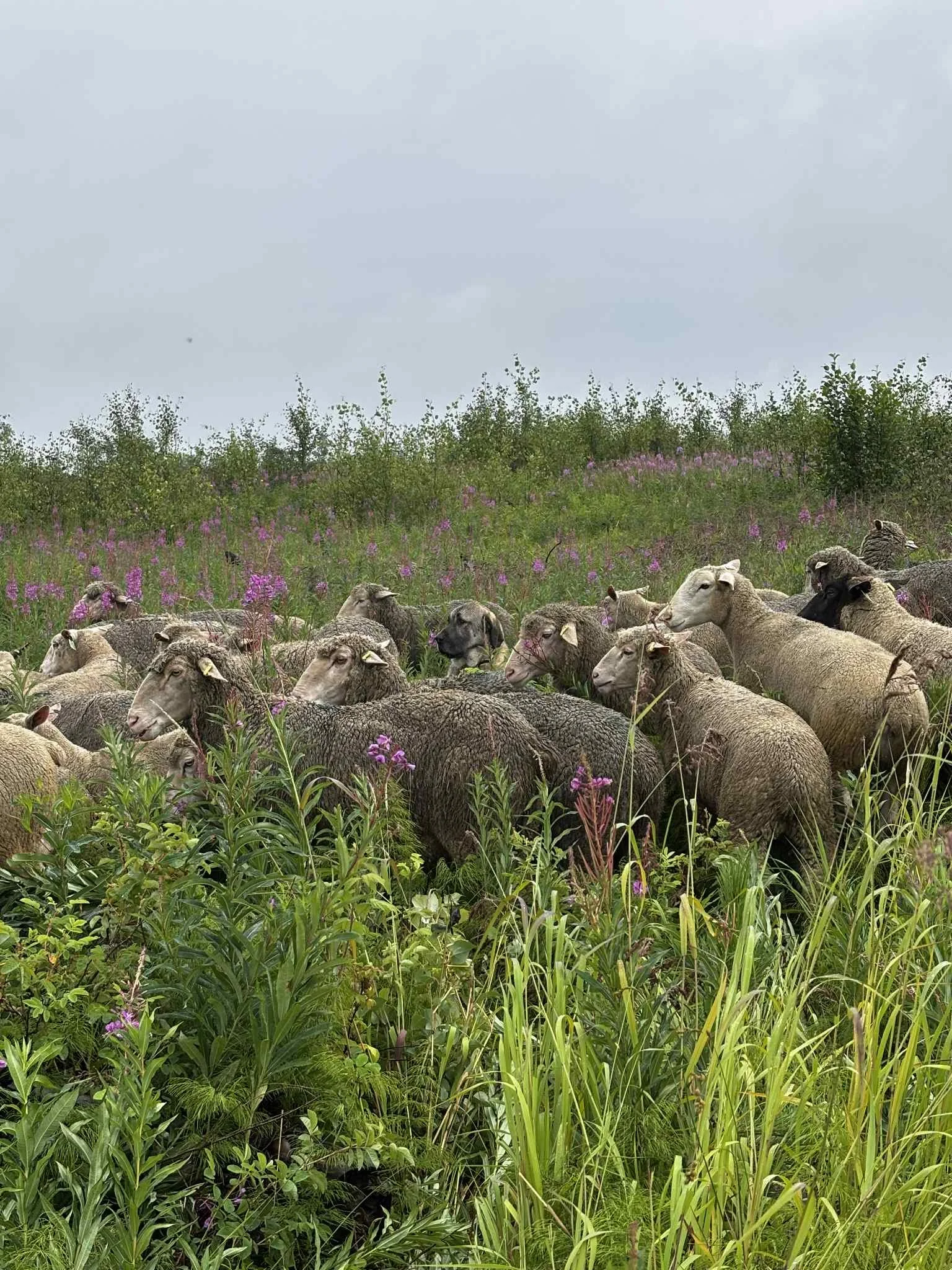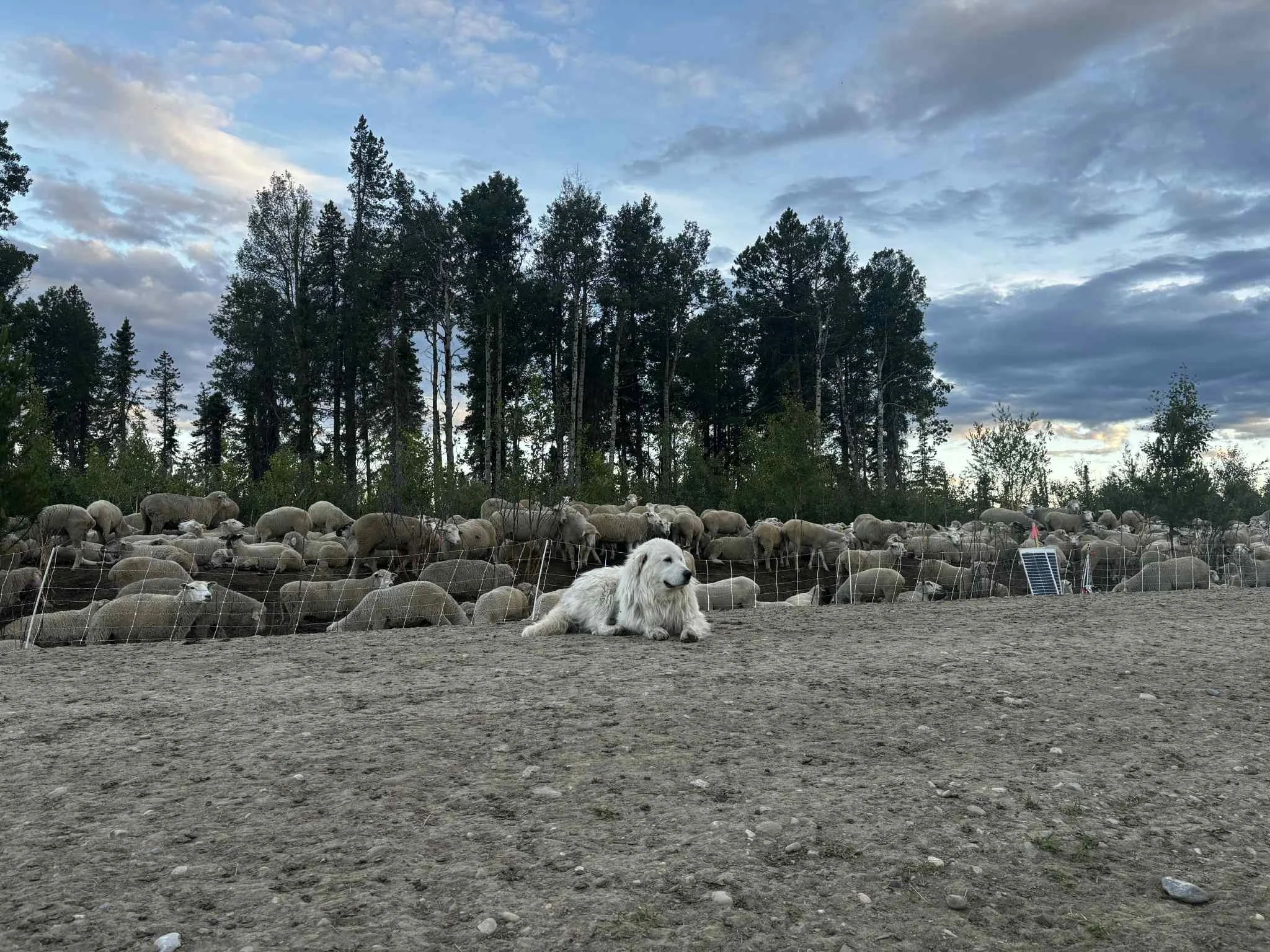Grazing the Wild: A Visit with Catie and Her Flock
Pictured above: High Country Shepherding’s remote camp setup besides the road. A perimeter of electric fencing helps keep wildlife, including grizzlies, at a safe distance. Photo by Farming Forward.
Edson, Yellowhead County - July 23, 2025
Just before noon, we pull off the logging road west of Edson and spot a small camp tucked away, four wall tents and a camper set up along the roadside. This is High Country Shepherding’s mobile basecamp, quiet for now. The sheep are out grazing on nearby cutblocks, and the night pen —an empty perimeter of electronet fencing— sits ready for their return.
Catie Maclennan-Dobson, founder and manager of High Country Shepherding, steps out to greet us, her dog at her side. She’s wearing a reflective vest and carries bear spray on her belt, both standard precautions in this landscape. “We saw a mom and cubs just yesterday,” she tells us, referring to the grizzly bears that frequent this area. It’s a striking reminder that this is real backcountry grazing.
Pictured above: The flock grazing through a reforested cutblock, surrounded by lush summer growth and blooming fireweed—one of their seasonal favourites. This low-impact grazing helps control competing vegetation while preserving plant diversity. Photo courtesy of High Country Shepherding.
A Living System on the Move
Each summer, High Country Shepherding brings a flock of about 1,200 sheep into reforested cutblocks to naturally manage vegetation. The sheep typically arrive two to three years after tree planting; when seedlings are hardy enough to withstand light grazing but still vulnerable to competition from fast-growing brush.
Unlike cattle, which can be rougher on young trees and terrain, sheep are gentle and selective grazers. They help maintain biodiversity while reducing the need for herbicide applications. “The alternative is glyphosate,” Catie explains. “There are less invasive sprays out there, but they usually require multiple passes and end up costing about the same as hiring us.” And in terrain like this, slashed, and full of debris, spraying by machine isn’t even an option. “You’d need to bring in helicopters or planes,” she adds. “It’s expensive, less targeted, and not exactly light on the land.”
The footprint of High Country Shepherding’s operation, by contrast, is impressively small. Camp runs on solar and propane, with no generators. Fuel is limited to vehicles and the occasional water pump. Thanks to a rainy season, even water hauling has been minimal, creeks and puddles have taken care of most of the supply.
A Day in the Life
Pictured above: Catie and her dog Meg standing in the slash-covered terrain. With dense brush and fallen logs underfoot, herding on foot is the only option. Photo by Farming Forward.
The shepherds’ day starts around 7:00 AM and winds down by 7:00 PM. When we reach the grazing site, the sheep are in their midday rest period, ruminating peacefully while herding dogs and shepherds take a rare moment to sit. It’s a rhythm shaped by animals, terrain, and weather. As the season progresses, the sheep’s grazing preferences shift —fireweed becomes a favourite once it begins to bloom. As the vegetation gets drier and more mature, the sheep tend to fill up faster, leading to shorter grazing bouts and more frequent, shorter rest breaks throughout the day.
The terrain is no joke. Fallen logs, dense brush, and uneven footing make herding on foot the only real option, quads are useless, and horses can be at risk of injury. Catie plans to bring in her own horse soon to help with scouting, especially in overgrown areas where the grass is as tall as she is, making it nearly impossible to see what lies ahead on foot.
Digital maps and GPS coordinates guide their grazing plans. With little to no cell service, the team communicates by radio. This season, four full-time shepherds and one relief shepherd rotate duties, with a rough rule of one shepherd per 500 sheep.
Pictured above: One of the livestock guardian dogs resting near the flock in the night pen. Calm but alert, these dogs are essential to the operation—protecting both sheep and shepherds from predators in the backcountry. Photo courtesy of High Country Shepherding.
The Importance of Dogs
Catie is quick to point out the real heroes of the operation: the dogs. Herding dogs move and manage the flock, while livestock guardian dogs keep both animals and people safe. “Not every dog is cut out for this work,” she says. Over time, she’s learned it’s best to raise her herding dogs from pups, since older, trained dogs often struggle to adapt to the unique demands of cutblock work.
The guardian dogs, on the other hand, thrive in this environment, even those that have been difficult at home. “A summer on the cutblocks can turn them around,” Catie says. With long days, daily exposure to wildlife, and constant supervision, it’s the perfect training ground for a young or unproven livestock guardian.
The two guardian dogs with the flock this season are becoming seasoned pros. They bark throughout the night, alerting the camp to everything from curious coyotes to real threats. Over time, the shepherds learn to read the dogs’ barks like a language.
Ecology Meets Practicality
Pictured above: Two curious bear cubs near camp, captured by Catie. Encounters like this are part of daily life for the crew, who work closely with Alberta Fish & Wildlife to track their movements and report wildlife activity in the area. Photo courtesy of High Country Shepherding.
Behind the scenes, the operation intersects with wildlife conservation and forestry regulation. Domestic sheep can carry pathogens like Mycoplasma ovipneumoniae, which pose serious risks to wild bighorn sheep through nose-to-nose contact. A drone is kept on hand to help spot missing sheep in open areas, though thick tree cover often limits its usefulness. Still, it’s an invaluable tool when the terrain allows. High Country Shepherding is monitored closely by Alberta Fish & Wildlife and submits regular reports about the flock’s movements. The agency also appreciates updates on wildlife sightings and other notable activity, which contribute to broader monitoring efforts.
As we continue to walk over the cutblocks, talking with Catie, we pass a pair of research plots set up by a university team: one grazed by the flock, the other fenced off and left untouched. The side-by-side comparison offers a valuable look at how targeted sheep grazing may influence seedling growth, plant communities, and overall biodiversity over time.
More Than a Job
Since founding High Country Shepherding in 2021, Catie has built more than a business—she’s created a model of regenerative land management rooted in tradition, adaptability, and boots-on-the-ground knowledge. She manages logistics, paperwork, reporting, hiring, and fieldwork, often all in the same day.
Her team’s work offers a compelling alternative to chemical vegetation control, while supporting reforestation goals and biodiversity in some of Alberta’s most rugged terrain.
As we scramble back over fallen logs and rough ground to the trucks, it's clear: this isn’t just hard work - it’s smart work. And we’re looking forward to sharing more soon. A video about our visit is in the works, so stay tuned.
To learn more about High Country Shepherding or inquire about contract grazing services, visit hcshepherding.ca or follow them on Instagram @high.country.shepherding.
This visit and interview were supported by the Stewardship Alliance for Conservation Agriculture (SACA) initiative, which promotes environmentally responsible land management practices in Yellowhead and Woodlands Counties.







